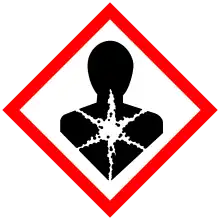Manganese(II) iodide
Manganese(II) iodide is the chemical compound composed of manganese and iodide with the formula MnI2(H2O)n. The tetrahydrate is a pink solid while the anhydrous derivative is beige.[2] Both forms feature octahedral Mn centers. Unlike MnCl2(H2O)4 and MnBr2(H2O)4 which are cis, MnI2(H2O)4 is trans.[3]
-iodide-xtal-layer-3D-bs-17.png.webp) | |
-iodide-xtal-packing-3D-bs-17.png.webp) | |
4.svg.png.webp) | |
| Names | |
|---|---|
| IUPAC name
Manganese(II) iodide | |
| Identifiers | |
3D model (JSmol) |
|
| ChemSpider | |
| ECHA InfoCard | 100.029.274 |
| EC Number |
|
PubChem CID |
|
| UNII | |
CompTox Dashboard (EPA) |
|
| |
| |
| Properties | |
| MnI2 | |
| Molar mass | 308.747 g/mol |
| Appearance | pink crystalline |
| Density | 5.01 g/cm3 |
| Melting point | 701 °C (1,294 °F; 974 K) (anhydrous) 80 °C (tetrahydrate) |
| Boiling point | 1,033 °C (1,891 °F; 1,306 K) |
| soluble | |
| +14,400·10−6 cm3/mol | |
| Structure | |
| Rhombohedral, hP3, SpaceGroup = P-3m1, No. 164 | |
| octahedral | |
| Hazards[1] | |
| GHS labelling: | |
 | |
| Danger | |
| H360 | |
| P201, P202, P281, P308+P313, P405, P501 | |
| NFPA 704 (fire diamond) | |
| Flash point | non-flammable |
| Related compounds | |
Other anions |
Manganese(II) fluoride Manganese(II) chloride Manganese(II) bromide |
Other cations |
Iron(II) iodide Cobalt(II) iodide |
Except where otherwise noted, data are given for materials in their standard state (at 25 °C [77 °F], 100 kPa).
Infobox references | |
Preparation
Anhydrous MnI2 is prepared from the elements:[4]
- Mn + I2 → MnI2
The tetrahydrate can be prepared by treating manganese(II) carbonate with hydriodic acid. The anhydrous form can be produced from it by dehydration in a vacuum.[2]
Properties
Samples turn brown in air under the influence of light as a result of the oxidation of the iodide ion to iodine.[5] It has a trigonal crystal structure of the cadmium iodide type (polytype 2H)[6][7] with the space group P3m1 (space group no. 164). It dissolves in water and decomposes.[5] The tetrahydrate has a monoclinic crystal structure with the space group P21/c (No. 14).[3]
Applications
It is often used in the lighting industry.[8]
References
- "223646 Manganese(II) iodide 98%". Sigma-Aldrich. Retrieved 2011-08-05.
- Hosseiny, Afshin; MacKie, Anthony G.; McAuliffe, Charles A.; Minten, Karl (1981). "The Coordination Chemistry of Manganese". Inorganica Chimica Acta. 49: 99–105. doi:10.1016/S0020-1693(00)90464-X.
- Moore, J. E.; Abola, J. E.; Butera, R. A. (1985-09-15). "Structure of manganese(II) iodide tetrahydrate, MnI2.4H2O". Acta Crystallographica Section C: Crystal Structure Communications. 41 (9): 1284–1286. doi:10.1107/S0108270185007466. ISSN 0108-2701.
- Friour, G.; Cahiez, G.; Normant, J. F. (1984). "Organomanganous Reagents; IX. Preparation of Various Halogenated, Alkoxylated, Aryloxylated, and Arylsulfenylated Ketones from Correspondingly Functionalized Carboxylic Acid Chlorides or Anhydrides". Synthesis. 1984: 37–40. doi:10.1055/s-1984-30724. S2CID 94812612.
- Ans, Jan d'; Ans, Jan d' (1998). Elemente, anorganische Verbindungen und Materialien. Taschenbuch für Chemiker und Physiker / D'Ans (4., neubearb. u. rev. Aufl ed.). Ort nicht ermittelbar: Verlag nicht ermittelbar. ISBN 978-3-540-60035-0.
- Riedel, Erwin; Alsfasser, Ralf, eds. (2007). Moderne anorganische Chemie: mit CD-ROM (3. Aufl ed.). Berlin: de Gruyter. ISBN 978-3-11-019060-1.
- Cable, J. W.; Wilkinson, M. K.; Wollan, E. O.; Koehler, W. C. (1962). "Neutron Diffraction Investigation of the Magnetic Order in MnI2". Phys. Rev. 125 (6): 1860–1864. doi:10.1103/PhysRev.125.1860.
- Cepanec, Ivica (2004). Synthesis of Biaryls. Elseveir. p. 104. ISBN 0-08-044412-1. Retrieved 2008-06-18.
